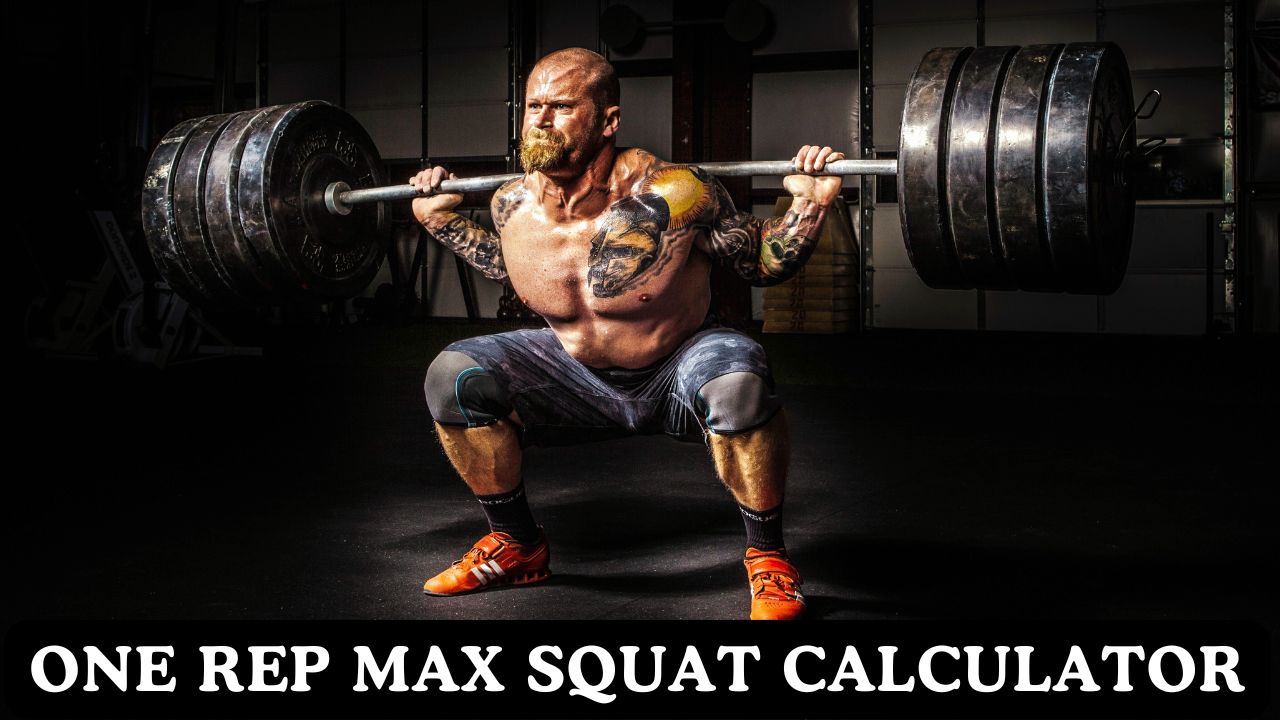One Rep Max Squat Calculator
Calculate your Squat One Rep Max (1RM) using scientifically validated formulas. Get personalized squat training recommendations and percentage-based workout plans optimized for maximum strength development.

Understanding Squat One Rep Max (1RM) Training
Scientific Foundation
The Squat One Rep Max (1RM) represents the maximum weight an individual can squat for a single repetition with proper form. Research in Sports Medicine demonstrates that squat 1RM testing is the gold standard for assessing lower body maximum strength. The squat engages multiple muscle groups including quadriceps, glutes, hamstrings, calves, and core muscles, making it one of the most comprehensive strength assessments available.
Biomechanical Importance
Biomechanical analysis shows that the squat is a fundamental movement pattern that translates to numerous athletic and daily activities. Squat 1RM correlates strongly with jumping performance, sprint speed, and overall lower body power output. The movement requires optimal coordination between hip, knee, and ankle joints while maintaining spinal stability.
Athletic Performance
Athletic performance research indicates that squat strength is a primary predictor of athletic success across multiple sports. Higher squat 1RM values correlate with improved vertical jump, sprint acceleration, and change of direction performance. Elite athletes typically demonstrate squat 1RM values of 1.5-2.5 times their body weight.
Functional Movement
Functional movement studies demonstrate that squat strength directly impacts quality of life and injury prevention. Strong squatters show reduced risk of knee injuries, improved balance, and better performance in activities of daily living. The squat pattern is essential for getting up from chairs, climbing stairs, and maintaining independence with aging.
Squat 1RM Calculation Methods & Formulas
Brzycki Formula for Squats
Formula: 1RM = Weight × 36 ÷ (37 – Reps)
Validation research
shows the Brzycki formula provides highly accurate 1RM predictions for squat movements. This formula is particularly
effective for rep ranges of 2-10 and has been validated across different squat variations including back squat and front squat.
Epley Formula for Squats
Formula: 1RM = Weight × (1 + 0.0333 × Reps)
The Epley formula is widely used in strength training and provides excellent accuracy for squat 1RM calculations.
This formula tends to be slightly more conservative than Brzycki, making it ideal for programming purposes where
safety margins are important. It works well across all squat variations and training levels.
Direct Squat 1RM Testing
Protocol: Progressive loading to determine actual squat 1RM
Direct squat 1RM testing involves systematic load increases with proper warm-up and safety protocols. This method
provides the most accurate assessment but requires experienced spotters, safety equipment, and optimal conditions.
Recommended only for experienced lifters with proper technique and adequate preparation.
Multi-Formula Average
Approach: Combined formula average for enhanced accuracy
Using multiple formulas and averaging results provides superior accuracy compared to single-formula calculations.
This method reduces individual formula bias and provides more reliable squat 1RM estimates across different
populations, training levels, and squat variations. Particularly valuable for program design and progression tracking.
Squat Variations & 1RM Relationships
| Squat Variation | % of Back Squat 1RM | Primary Muscles | Difficulty Level | Best For |
|---|---|---|---|---|
| Back Squat | 100% | Quads, Glutes, Hamstrings | Moderate | Maximum strength |
| Front Squat | 80-85% | Quads, Core, Upper Back | High | Quad development |
| Overhead Squat | 60-70% | Full body, Stability | Very High | Mobility, stability |
| Goblet Squat | 40-50% | Quads, Glutes, Core | Low | Beginners, form |
| Box Squat | 85-95% | Posterior chain | Moderate | Power development |
| Bulgarian Split | 30-40% (per leg) | Unilateral strength | High | Balance, unilateral |
Squat Variation Selection
Choose squat variations based on your training goals, experience level, and mobility limitations. Back squats provide maximum loading potential, while front squats emphasize quadriceps and core strength. Overhead squats challenge mobility and stability, making them excellent for athletic development. Goblet squats are perfect for beginners learning proper squat mechanics.
Squat 1RM Strength Standards
Male Squat 1RM Standards (kg)
| Body Weight | Beginner | Novice | Intermediate | Advanced | Elite |
|---|---|---|---|---|---|
| 60kg | 50kg | 75kg | 105kg | 135kg | 165kg |
| 70kg | 60kg | 85kg | 120kg | 155kg | 185kg |
| 80kg | 70kg | 100kg | 135kg | 170kg | 205kg |
| 90kg | 80kg | 110kg | 150kg | 185kg | 225kg |
| 100kg | 85kg | 120kg | 160kg | 200kg | 240kg |
Female Squat 1RM Standards (kg)
| Body Weight | Beginner | Novice | Intermediate | Advanced | Elite |
|---|---|---|---|---|---|
| 50kg | 30kg | 50kg | 70kg | 90kg | 115kg |
| 60kg | 40kg | 60kg | 85kg | 110kg | 135kg |
| 70kg | 45kg | 70kg | 95kg | 125kg | 155kg |
| 80kg | 50kg | 75kg | 105kg | 135kg | 170kg |
| 90kg | 55kg | 80kg | 115kg | 145kg | 180kg |
Squat Standards Interpretation
These squat 1RM standards are based on extensive strength data from recreational to competitive lifters. Standards assume proper back squat technique, adequate training experience, and good health status. Individual variations exist based on limb lengths, training history, genetics, and age. Use these standards as general guidelines for setting realistic strength goals and tracking progress over time.
Squat 1RM Periodization Model
| Training Phase | Duration | Intensity (%1RM) | Volume (Reps) | Sets | Rest Period | Primary Adaptation |
|---|---|---|---|---|---|---|
| Anatomical Adaptation | 4-6 weeks | 50-70% | 12-20 | 2-3 | 1-2 min | Technique, endurance |
| Hypertrophy | 4-6 weeks | 65-80% | 6-12 | 3-4 | 2-3 min | Muscle growth |
| Maximum Strength | 4-6 weeks | 80-95% | 1-6 | 4-6 | 3-5 min | Neural adaptation |
| Power | 3-4 weeks | 30-60% | 3-6 | 3-5 | 3-5 min | Rate of force development |
| Peaking | 2-3 weeks | 85-100% | 1-3 | 3-5 | 3-5 min | Competition preparation |
| Recovery | 1-2 weeks | 40-60% | 8-15 | 2-3 | 1-2 min | Active recovery |
Squat Periodization Benefits
Periodization research demonstrates that systematic variation in squat training intensity and volume produces superior strength gains compared to non-periodized approaches. Proper periodization prevents plateaus, reduces injury risk, and optimizes peak performance for competition or testing. The squat responds particularly well to block periodization models.
Advanced Squat Training Techniques
Pause Squats
Protocol: 2-3 second pause at bottom position
Benefits: Improved strength off chest, enhanced control
Pause squats eliminate the stretch-shortening cycle, requiring greater strength and stability. Use 80-90% of regular
squat 1RM for pause squats. Excellent for powerlifting preparation and addressing sticking points.
Tempo Squats
Method: Controlled eccentric (3-5 seconds down)
Benefits: Increased time under tension, improved control
Tempo squats enhance strength in the lengthened position and improve eccentric strength. Use 60-80% of 1RM
with various tempo prescriptions (e.g., 3-1-1-1 or 5-2-1-1).
Box Squats
Setup: Squat to box, brief pause, explosive up
Benefits: Posterior chain emphasis, power development
Box squats teach proper hip hinge mechanics and develop explosive strength. Can handle similar loads to
regular squats while emphasizing different muscle groups and movement patterns.
Frequently Asked Questions
How often should I test my squat 1RM?
Beginners: Every 8-12 weeks during strength phases
Intermediate: Every 6-8 weeks or at mesocycle transitions
Advanced: Every 4-6 weeks during peaking phases
Powerlifters: 2-4 weeks before competition
Avoid frequent 1RM testing as it’s neurally demanding and increases injury risk. Use submaximal testing when possible.
What’s the proper squat 1RM testing protocol?
Warm-up Protocol:
1. General warm-up: 10-15 minutes dynamic movement
2. Bodyweight squats and mobility work
3. 40% 1RM × 8 reps
4. 60% 1RM × 5 reps
5. 80% 1RM × 3 reps
6. 90% 1RM × 1 rep
7. 100% 1RM attempt
Rest 3-5 minutes between heavy sets, ensure safety equipment is properly set.
What are common squat 1RM testing mistakes?
Avoid These Errors:
• Insufficient warm-up or excessive warm-up volume
• Poor safety bar positioning or no spotter
• Testing when fatigued or inadequately recovered
• Compromising depth for heavier weight
• Attempting 1RM without proper technique mastery
• Testing too frequently (more than monthly)
• Ignoring individual mobility limitations
How does squat 1RM relate to other lifts?
Typical Strength Ratios:
• Deadlift: 110-120% of squat 1RM
• Bench Press: 70-80% of squat 1RM
• Overhead Press: 50-60% of squat 1RM
• Front Squat: 80-85% of back squat 1RM
These ratios vary based on individual leverages, training history, and specialization. Use as general guidelines
for balanced strength development.
What safety equipment is essential for squat 1RM testing?
Essential Safety Equipment:
• Power rack or squat rack with adjustable safety bars
• Proper Olympic barbell and calibrated plates
• Experienced spotter(s) familiar with squat safety
• Appropriate footwear (flat, stable shoes)
• Optional: lifting belt, knee sleeves, wrist wraps
Never attempt maximum squats without proper safety measures in place.
Squat Safety & Injury Prevention
Pre-Squat Mobility Requirements
Essential Mobility Areas:
• Ankle dorsiflexion: 35-40 degrees minimum
• Hip flexion: 120+ degrees for deep squats
• Thoracic spine extension: Maintain neutral spine
• Shoulder mobility: For proper bar positioning
Address mobility limitations before attempting heavy squats. Poor mobility leads to compensations and injury risk.
Common Squat Injuries & Prevention
Injury Prevention Strategies:
• Knee injuries: Proper tracking, adequate warm-up
• Lower back: Maintain neutral spine, core stability
• Hip impingement: Address mobility, proper depth
• Shoulder issues: Correct bar position, flexibility
Most squat injuries result from poor technique, inadequate preparation, or training errors rather than the exercise itself.
Post-Squat Recovery Protocol
Recovery Strategies:
• Immediate: Light walking, gentle stretching
• 24 hours: Contrast showers, protein intake
• 48 hours: Light movement, monitor soreness
• Return to training: Gradual load progression
Heavy squat sessions require 48-72 hours recovery for optimal adaptation and injury prevention.
Related
- Barbell Racking Calculator
- Push-Up Weight Calculator
- Wilks Calculator
- DOTS Calculator
- One-Rep (1RM) Max Calculator
- One-Rep Max (1RM) Bench Press Calculator
References
- Knutzen, Kathleen; Brilla, Lorraine; Caine, Dennis (August 1999). “Validity of 1RM Prediction Equations for Older Adults”. The Journal of Strength & Conditioning Research. 13 (3): Vol 13, Issue 3, Page 242–246. Retrieved 11 July 2014.
- Epley, Boyd (1985). “Poundage Chart”. Boyd Epley Workout. Lincoln, NE: Body Enterprises. p. 86.
- Brzycki, Matt (1998). A Practical Approach To Strength Training. McGraw-Hill.
- Kemmler, Wolfgang K.; Lauber, Dirk; Wassermann, Alfred; Mayhew, Jerry L. (2006-11-01). “Predicting maximal strength in trained postmenopausal woman”. Journal of Strength and Conditioning Research. 20 (4): 838–842.
- Reynolds, JM; Gordon, TJ; Robergs, RA (August 2006). “Prediction of one repetition maximum strength from multiple repetition maximum testing and anthropometry” (PDF). Journal of Strength and Conditioning Research. 20 (3): 584–92.
- Naclerio Ayllón, Fernando; Jiménez Gutiérrez, Alfonso; Alvar, Brent A.; Peterson, Mark D. (2009). “Assessing strength and power in resistance training”. Journal of Human Sport and Exercise. 4 (2): 100–113.

Manish is a NASM-certified fitness and nutrition coach with over 10 years of experience in weight lifting and fat loss fitness coaching. He specializes in gym-based training and has a lot of knowledge about exercise, lifting technique, biomechanics, and more.
Through “Fit Life Regime,” he generously shares the insights he’s gained over a decade in the field. His goal is to equip others with the knowledge to start their own fitness journey.
